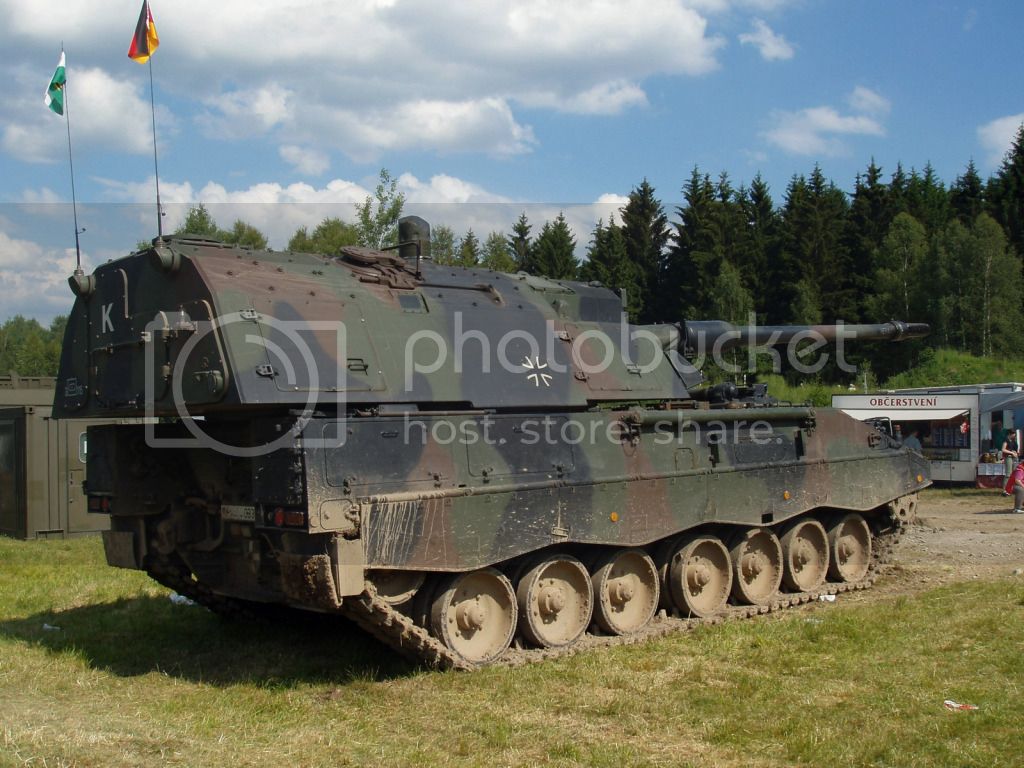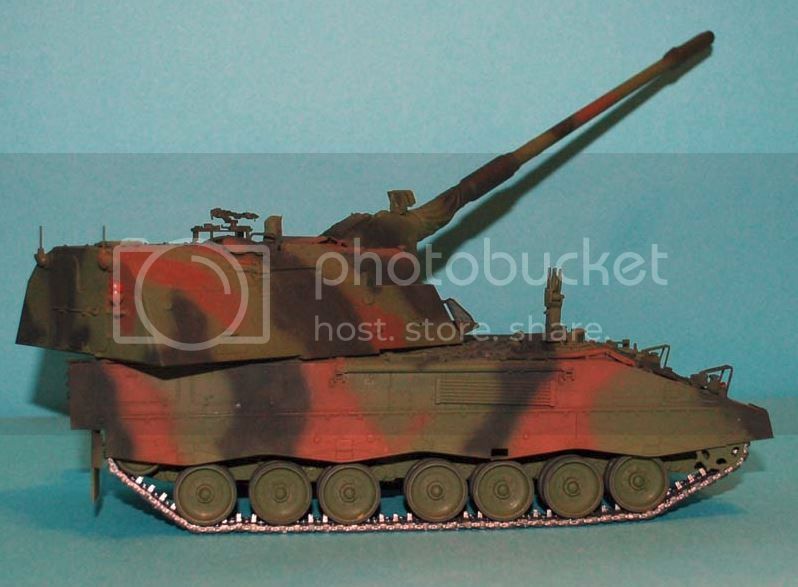1⁄35Panzerhaubitze 2000 build
10
Comments
Introduction
When it comes to the Panzerhaubitze 2000 the only available model in 1/35th scale was that by Revell of Germany, but that has now been superseded by a new offering from Meng Model. A lot has been said about this model and as such this review will concentrate on how buildable it is, rather than on its accuracy, though I will of course point out anything of questionable accuracy as I go.Product Quality
First off, I am very impressed by the quality of the packaging of this model, which means it should always arrive in good condition: the tracks are separately boxed, as is the metal barrel, the sprues are packed in individual plastic bags, only doubling up where there are pairs of identical sprues. The mouldings have a little flash in places, but it is minor. The kit is free of excessive seam lines, and although the ejector pin marks all look to be on areas that won’t be seen on the finished model, some of them are surprisingly large which is disappointing to see on a model of this quality. The only moulding fault that is visible are flow/cooling lines, but the ones present on this example, thankfully all feel and look to be fully closed up. One thing I observed is that some of the sprue gates are a little on the large size.The Build
Wheels and Suspension Step 1 starts in the usual place with the wheels. This kit uses what I call the ‘Tamiya method’, meaning poly caps are used to attach the wheels to the suspension arms. I actually like this as it makes for easy painting and allows removal of the wheels for weathering. Clean up of the toothed drive wheels requires care as it would be very easy to cut into the teeth or the ring. Closing up the drive and idler wheel is simplicity itself; however the same cannot be said for the road wheels: the shallow ring used for locking the wheel halves together is too shallow and does not provide a positive lock. On the plus side there is no moulding seam around the track contact surface of the wheels requiring attention. I have not cleaned up the sprue gate at this point, as I prefer to do that after the wheels are glued together; this helps to ensure the blade is kept at 90 degrees to the surface and any extra sanding required is also at the correct angle, rather than wearing down one side more than the other. Stud patterns on all of the wheels look to be accurate, but the bolt detail is a little soft. Step 2 starts with the addition of the return roller mounting brackets, which fit very well due to very positive contact between hull and brackets. I do have one concern, which is that it is very easy to mount these brackets upside down; this problem could easily have been overcome by Meng had the shaped connecters been designed to fit one way up rather than either, so take care when adding these parts. The bump stops are also added at this point and again Meng has supplied a very positive connection both in terms of placement and creating a rigid joint. While covering step two, make sure you remember to drill the 1mm holes at the rear of the lower hull on the right. Step 3 covers the 5 shocks down each side of the hull and the mount and adjuster for the rear idler wheel. Meng has again provided very positive locations and joint strength for these parts. Clean up is straight forward, with the exception of the idler mount and adjuster, where things are a little more involved. Step 4 covers the addition of the torsion bar suspension which is workable, and it’s one of the easiest assemblies for successfully creating a workable joint that I have come across. Both the suspension arm and torsion bar are supplied as a single moulding which keeps things simple. Once the parts are cleaned, insert the torsion bar through the relevant hole in the hull and then slot it into a simple retainer moulded as part of the hull on the opposite side. When all of the torsion bars are inserted from one side, add a small amount of adhesive to keep them in place and allow them to cure fully before attaching the torsion bars on the other side; this should ensure that even the most haphazard glue application will leave you with a posable suspension. During this stage you are also confronted with deciding one of the finishing options: the mounting plate with a hook, or a mounting bracket with nothing attached; I would have liked to see the option of a separate hook or shackle. Step 5 covers attaching the wheels to the model. For the purpose of this build review I have added the main wheels but not the return rollers, until I have got some paint down. I would not normally add the wheels at this point as it will make painting difficult, and while the poly caps make removal easy, it could result in damage if care is not taken. Something for you to consider regarding the wheels: I cut the sprue gates fairly close to the wheel mouldings and then used a course sand paper to remove the remains of the gate, and by taking that sanding action around the full circumference, you get a realistic worn look to the rubber portion of the wheels.Comments
Hi Darren,
thanks for sharing this extensive build. Very helpfull.
Good to see one of the, if not the, best guns in the world at this moment as a decent model. You did a lot of detailed work!
The only remark, please, if allowed, is the camo pattern. Pls., do have a look at Google and see that the overal impression of these howitsers is far less red, but more dark. Less than 20% of the surface should be painted brown. Furthermore, the edges of the camo should be rather sharp.
But.....
All together, i like the build and your comment.
P.
NOV 21, 2014 - 07:43 PM
Regarding the end comments, yeah the Greek version is tempting, LM Decals recently released decals for it.
LINK
Cheers,
Christophe
NOV 21, 2014 - 08:08 PM
Impressive build Darren, Congratulations !
This could be something for me, i will return to do 1/35 scale AfVs in the future, as well the 1/72 scale kits.
Got a Meng Leopard, may i can did out a build here.
Cheers
Bernd
NOV 21, 2014 - 08:51 PM
Paul if you take a look at the darker pictures it shows the colour as it appears to the naked eye, the red colour occured after I balanced the pictyre in Photo Shop. I am surprised on your comments about camouflage layout as I used ref pics online and checked them against what Meng offered, I accept it is not 100% but it is close.
Thank you for your comments guys.
NOV 22, 2014 - 12:45 AM
Hi Darren, i took the liberty to comment since I have worked with these guns as an art Lcol! Actually, now I am rather confused since neither the Germans nor the Dutch have this camo pattern, so is it your intention to go further into the 4 color Greek scheme?
NOV 22, 2014 - 10:34 PM
Paul; No that is the finished main painting and I was sure I was close, I am a little rattled now as I believed I had got it right, but thank you for pointing out I have got it wrong. As you have worked on these can you show me some pics of the tools on the vehicle please, I assume they are overall green with some wear and tear present.
NOV 23, 2014 - 12:29 AM
If you compare this German scheme (photo from Prime Portal) you can see that the brown pattern in the middle is different from your portrayal. There are lots of photos on the Internet to verify - I don't know if your pattern is based on the instructions but it never hurts to double check!

 Jim
Jim

 Jim
JimNOV 23, 2014 - 01:47 AM
Hi Daren,
first of all, I believe that the most important of modeling is the fact that one enjoys building and painting.
So, I am not supposed to ordeal on that.
But the camouflage pattern on the PzH2000, if used by the German or Dutch army, show differrent patterns. Spots, no bands! Only in Afghanistan, mud was used to camouflage them, though one can discuss the (non)sence of that, based on the huge defence around these important vehicles, static and while travelling (Their value was so high that they were flown back to Europe in stead of using road and sea transport from Afghanistan)
About the tools: they were supplied together with the vehicles, thus having a NATO olive color, with, in rare cases, clear wooden parts. However, most of it was just green, close to the base vehicle colour. The wear and tear is rather rare since these vehicles do "suffer" from budget reductions, thus being used rather seldomly. Money makes the world go around, even in the army!
NOV 23, 2014 - 01:53 AM
Thank you for your review and reports of the build. Since the finished model was photographed under poor lighting, I suggest that the reddish colour i the result of the camera trying to make a picture, and not be too accurate about it. I am a modeler, and have considerable photographic experience, having worked in labs and studios during the Kodak years, in both black and white and colour, in mixing and monitoring, quality control, etc. The model looks great Darren!
MAY 17, 2016 - 04:35 AM
Copyright ©2021 by Darren Baker. Images and/or videos also by copyright holder unless otherwise noted. The views and opinions expressed herein are solely the views and opinions of the authors and/or contributors to this Web site and do not necessarily represent the views and/or opinions of Armorama, KitMaker Network, or Silver Star Enterrpises. All rights reserved. Originally published on: 2014-11-22 06:01:46. Unique Reads: 22767






















